Lupe Velez (1908-1944), was one of the first Mexican actresses to succeed in Hollywood. Her nicknames were 'The Mexican Spitfire' and 'Hot Pepper'. She was the leading lady in such silent films as The Gaucho (1927), Lady of the Pavements (1928), and Wolf Song (1929). During the 1930s, her well-known explosive screen persona was exploited in a series of successful films like Hot Pepper (1933), Strictly Dynamite (1934), and Hollywood Party (1934). In the 1940s, Vélez's popularity peaked after appearing in the Mexican Spitfire films, a series created to capitalise on Vélez's well-documented fiery personality. She had several highly publicised romances and stormy marriage. In 1944, Vélez died of an intentional overdose of the barbiturate drug Seconal. Her death and the circumstances surrounding it have been the subject of speculation and controversy.
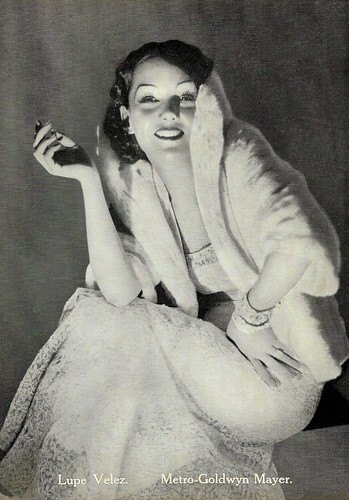
Dutch postcard by Smeets & Schippers, Amsterdam. Photo: George Hurrell / MGM (Metro-Goldwyn-Mayer).
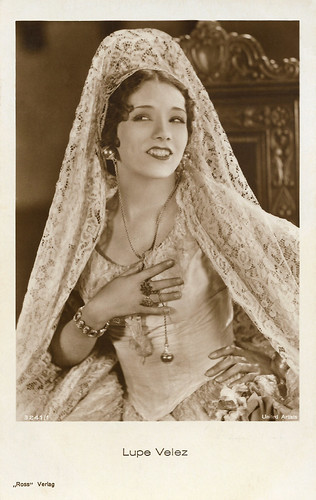
German postcard by Ross Verlag, no. 3241/1, 1928-1929. Photo: United Artists. Lupe Velez in The Gaucho (F. Richard Jones, 1929).

German postcard by Ross Verlag, no. 4116/1, 1929-1930. Photo: United Artists. Lupe Velez in Lady of the Pavements (D.W. Griffith, 1929).
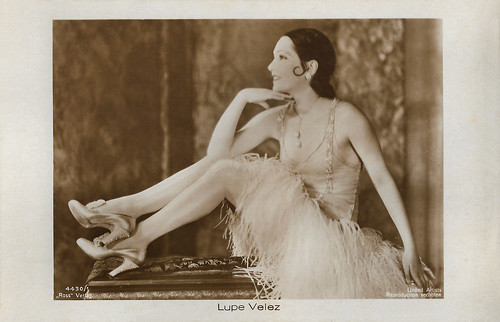
German postcard by Ross Verlag, no. 44301/1, 1929-1930. Photo: United Artists.
Lupe Vélez was born María Guadalupe Villalobos Vélez in 1908 in the city of San Luis Potosí in Mexico. She was the daughter of Jacobo Villalobos Reyes, a colonel in the army of the dictator Porfirio Diaz, and his wife Josefina Vélez, an opera singer according to some sources, or vaudeville singer according to others. She had three sisters: Mercedes, Reina, and Josefina, and a brother, Emigdio.
The family was financially comfortable and lived in a large home. At the age of 13, her parents sent her to study at Our Lady of the Lake (now Our Lady of the Lake University) in San Antonio, Texas. It was at Our Lady of the Lake that Vélez learned to speak English and began to dance. She later admitted that she liked dance class, but was otherwise a poor student.
Denny Jackson at IMDb: "Life was hard for her family, and Lupe returned to Mexico to help them out financially. She worked as a salesgirl for a department store for the princely sum of $4 a week. Every week she would turn most of her salary over to her mother, but kept a little for herself so she could take dancing lessons. By now, she figured, with her mature shape and grand personality, she thought she could make a try at show business."
She began her career as a performer in Mexican vaudeville in 1924. She initially performed under her paternal surname, but after her father returned home from the war, he was outraged that his daughter had decided to become a stage performer. She chose her maternal surname, 'Vélez', as her stage name, and her mother introduced Vélez and her sister Josefina to the popular Spanish Mexican vedette María Conesa, 'La Gatita Blanca'.
Vélez debuted in a show led by Conesa, where she sang 'Oh Charley, My Boy' and danced the shimmy. Aurelio Campos, a young pianist, and friend of the Vélez sisters recommended Lupe to stage producers, Carlos Ortega and Manuel Castro. Ortega and Castro were preparing a season revue at the Regis Theatre and hired Vélez to join the company in March 1925.
Later that year, Vélez starred in the revues 'Mexican Rataplan' and '¡No lo tapes!', both parodies of the Bataclan's shows in Paris. Her suggestive singing and provocative dancing were a hit with audiences, and she soon established herself as one of the main stars of vaudeville in Mexico. After a year and a half, Vélez left the revue after the manager refused to give her a raise.
She then joined the Teatro Principal but was fired after three months due to her "feisty attitude". Vélez was quickly hired by the Teatro Lirico, where her salary rose to 100 pesos a day. In 1926, Frank A. Woodyard, an American who had seen Vélez perform, recommended her to stage director Richard Bennett, the father of actresses Joan Bennett and Constance Bennett.
Bennett was looking for an actress to portray a Mexican cantina singer in his upcoming play 'The Dove'. He sent Vélez a telegram inviting her to Los Angeles to appear in the play. Vélez had been planning to go to Cuba to perform, but quickly changed her plans and traveled to Los Angeles. However, upon arrival, she discovered that she had been replaced by another actress.
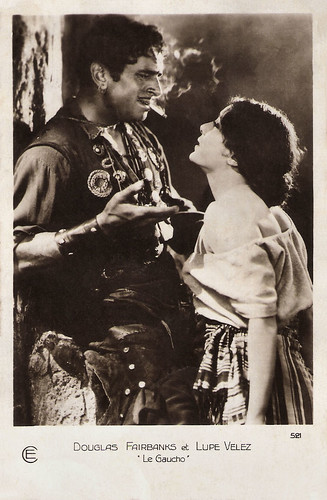
French postcard by Cinémagazine-Edition, Paris, no. 521. Douglas Fairbanks and Lupe Velez in The Gaucho (F. Richard Jones, 1927). Sent by mail in 1930.
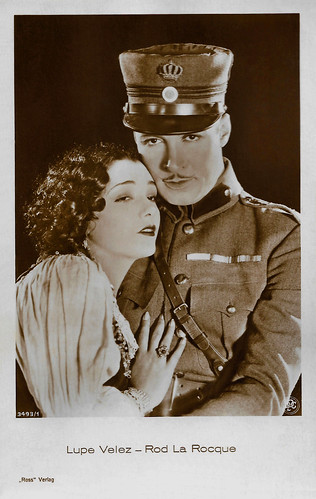
German postcard by Ross Verlag, no. 3493/1, 1928-1929. Photo: P.D.C. Lupe Velez and Rod La Rocque in Stand and Deliver (Donald Crisp, 1928).

French postcard by Europe, no. 457. Photo: United Artists / Regal Film.
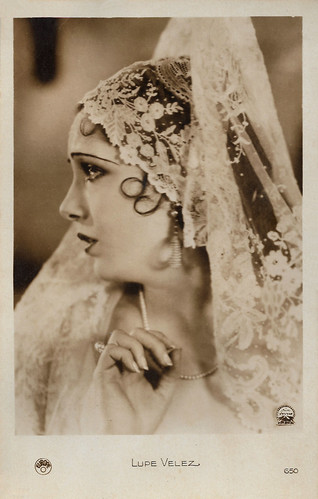
French postcard by Europe, no. 650. Photo: Paramount. Lupe Velez in The Wolf Song (Victor Fleming, 1929).
While in Los Angeles, Lupe Vélez met the comedian Fanny Brice. Brice recommended her to Florenz Ziegfeld Jr., who hired her to perform in New York City. While Vélez was preparing to leave Los Angeles, she received a call from MGM producer Harry Rapf, who offered her a screen test. Producer and director Hal Roach saw Vélez's screen test and hired her for a small role in the comic Laurel and Hardy short Sailors, Beware! (Fred Guiol, Hal Yates, 1927).
After her debut, Vélez appeared in another Hal Roach short, What Women Did for Me (James Parrott, 1927), opposite Charley Chase. Later that year, she did a screen test for the upcoming Douglas Fairbanks feature The Gaucho (F. Richard Jones, 1927). Fairbanks was impressed by Vélez and hired her to appear in the film with him.
The Gaucho (F. Richard Jones, 1927) was a hit and critics were duly impressed with Vélez's ability to hold her own alongside Fairbanks, who was well known for his spirited acting and impressive stunts. Her second major film was Stand and Deliver (Donald Crisp, 1928), produced by Cecil B. DeMille. That same year, she was named one of the WAMPAS Baby Stars.
Then she appeared in Lady of the Pavements (1929), directed by D. W. Griffith, and Where East Is East (Tod Browning, 1929), starring Lon Chaney as an animal trapper in Laos. In the Western The Wolf Song (Victor Fleming, 1929), she appeared alongside Gary Cooper. As she was regularly cast as 'exotic' or 'ethnic' women that were volatile and hot-tempered, gossip columnists took to referring to Vélez as "Mexican Hurricane", "The Mexican Wildcat", "The Mexican Madcap", "Whoopee Lupe" and "The Hot Tamale".
Lupe Vélez made the transition to sound films without difficulty. Studio executives had predicted that her accent would likely hamper her ability to make the transition. That idea was dispelled after she appeared in the all-talking Rin Tin Tin vehicle, Tiger Rose (George Fitzmaurice, 1929). The film was a hit and Vélez's sound career was established.
Vélez appeared in a series of Pre-Code films like Hell Harbor (Henry King, 1930), The Storm (William Wyler, 1930), and the crime drama East Is West (Monta Bell, 1930) opposite Edward G. Robinson. The next year, she appeared in her second film for Cecil B. DeMille, Squaw Man (Cecil B. DeMille, 1931), opposite Warner Baxter, in Resurrection (Edwin Carewe, 1931), and The Cuban Love Song (W.S. Van Dyke, 1931), with the popular singer Lawrence Tibbett.
She had a supporting role in Kongo (William J. Cowen, 1932) with Walter Huston, a sound remake of West of Zanzibar (Tod Browning, 1928) which tries to outdo the Lon Chaney original in morbidity. She also starred in Spanish-language versions of Universal films like Resurrección (Eduardo Arozamena, David Selman, 1931), the Spanish version of Resurrection (1931), and Hombres en mi vida (Eduardo Arozamena, David Selman, 1932), the Spanish version of Men in Her Life (William Beaudine, 1931) in which Lois Moran had starred.
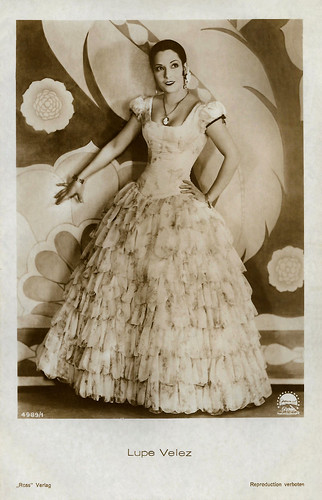
German postcard by Ross Verlag, no. 4989/1, 1929-1930. Photo: Paramount. Lupe Velez in The Wolf Song (Victor Fleming, 1929). Sent by mail in The Netherlands in 1932.
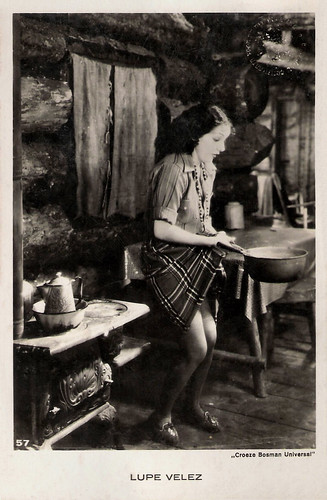
Dutch postcard by Croeze Bosman Universal, no. 57. Lupe Velez in The Storm (William Wyler, 1930).
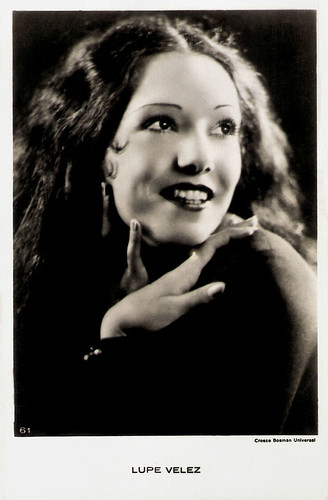
Dutch postcard by Croeze Bosman Universal, no. 61.
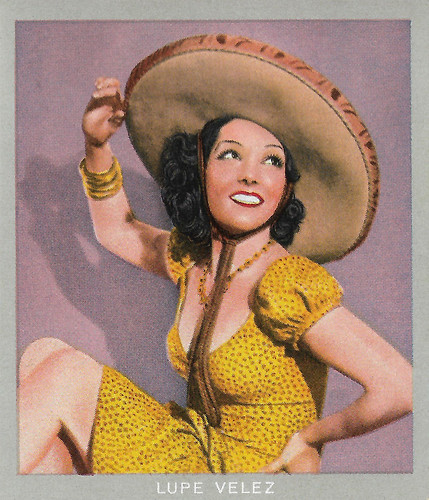
German cigarette card by Ross Verlag in the 'Künstler im Film' series for Zigarettenfabrik Monopol, Dresden, Serie 1, image 152 (of 200). Photo: Paramount. Lupe Velez in The Broken Wing (Lloyd Corrigan, 1932).
In 1932, Lupe Vélez took a break from her film career and traveled to New York City where she was finally signed by Broadway impresario Florenz Ziegfeld, Jr. to take over the role of 'Conchita' in the musical revue 'Hot-Cha!'. The show also starred Bert Lahr, Eleanor Powell, and Buddy Rogers.
Back in Hollywood, Lupe switched to comedy after playing dramatic roles for five years. Denny Jackson at IMDb: "In 1933 she played the lead role of Pepper in Hot Pepper (1933). This film showcased her comedic talents and helped her to show the world her vital personality. She was delightful."
After Hot Pepper (John G. Blystone, 1933) with Edmund Lowe and Victor McLaglen, Lupe played beautiful but volatile, characters in a series of successful films like Strictly Dynamite (Elliott Nugent, 1934), Palooka (Benjamin Stoloff, 1934) both opposite Jimmy Durante, and Hollywood Party (Allan Dwan, a.o., 1934) with Laurel and Hardy.
Although Vélez was a popular actress, RKO Pictures did not renew her contract in 1934. Over the next few years, Vélez worked for various studios as a freelance actress; she also spent two years in England where she filmed The Morals of Marcus (Miles Mander, 1935) and Gypsy Melody (Edmond T. Gréville, 1936). She returned to Los Angeles the following year where she appeared in the final part of the Wheeler & Woolsey comedy High Flyers (Edward F. Cline, 1937).
In 1938, Vélez made her final appearance on Broadway in the musical 'You Never Know', by Cole Porter. The show received poor reviews from critics but received a large amount of publicity due to the feud between Vélez and fellow cast member Libby Holman. Holman was irritated by the attention Vélez garnered from the show with her impersonations of several actresses including Gloria Swanson, Katharine Hepburn, and Shirley Temple. The feud came to a head during a performance in New Haven, Connecticut after Vélez punched Holman in between curtain calls and gave her a black eye. The feud effectively ended the show.
Upon her return to Mexico City in 1938 to star in her first Mexican film, Vélez was greeted by ten thousand fans. The film La Zandunga (Fernando de Fuentes, 1938) co-starring Arturo de Córdova, was a critical and financial success. Vélez was slated to appear in four more Mexican films, but instead, she returned to Los Angeles and went back to work for RKO Pictures.
In 1939, Lupe Vélez was cast opposite Leon Errol and Donald Woods in the B-comedy, The Girl from Mexico (Leslie Goodwins, 1939). Despite being a B film, it was a hit with audiences and RKO re-teamed her with Errol and Wood for a sequel, Mexican Spitfire (Leslie Goodwins, 1940). That film was also a success and led to a series of eight Spitfire films.
Wikipedia: "In the series, Vélez portrays Carmelita Lindsay, a temperamental yet friendly Mexican singer married to Dennis 'Denny' Lindsay (Woods), an elegant American gentleman. The Spitfire films rejuvenated Vélez's career. Moreover, they were films in which a Latina headlined for eight films straight – a true rarity."
In addition to the Spitfire series, she was cast in such films as Six Lessons from Madame La Zonga (John Rawlins, 1941), Playmates (David Butler, 1941) opposite John Barrymore, and Redhead from Manhattan (Lew Landers, 1943). In 1943, the final film in the Spitfire series, Mexican Spitfire's Blessed Event (Leslie Goodwins, 1943), was released. By that time, the novelty of the series had begun to wane.
Velez co-starred with Eddie Albert in the romantic comedy, Ladies' Day (Leslie Goodwins, 1943), about an actress and a baseball player. In 1944, Vélez returned to Mexico to star in an adaptation of Émile Zola's novel Nana (Roberto Gavaldón, Celestino Gorostiza, 1944), which was well-received. It would be her final film. After filming wrapped, Vélez returned to Los Angeles and began preparing for another stage role in New York.
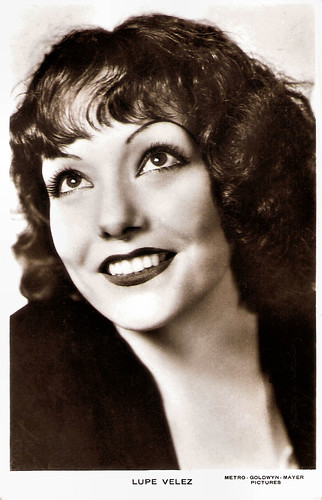
British Real Photograph postcard. Photo: Metro-Goldwyn-Mayer.

Italian postcard by Cinema-Illustrazione, Milano, Serie 1, no. 36. Photo: Metro-Goldwyn-Mayer.
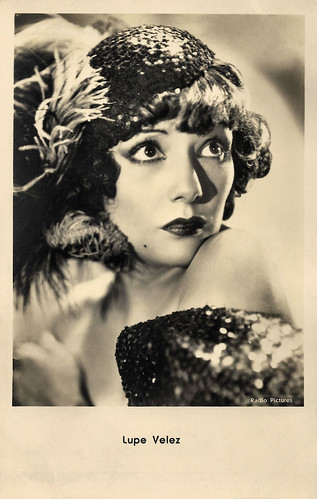
Austrian postcard by Iris Verlag, no. 6744. Photo: Radio Pictures.
Lupe Vélez's temper and jealousy in her often tempestuous romantic relationships were well documented and became tabloid fodder, often overshadowing her career. Vélez was straightforward with the press and was regularly contacted by gossip columnists for stories about her romantic exploits.
Her first long-term relationship was with actor Gary Cooper. Vélez met Cooper while filming The Wolf Song in 1929 and began a two-year affair with him. The relationship was passionate but often stormy. Reportedly Vélez chased Cooper around with a knife during an argument and cut him severely enough to require stitches. By that time, the rocky relationship had taken its toll on Cooper who had lost 45 pounds and was suffering from nervous exhaustion. Paramount Pictures ordered him to take a vacation to recuperate. While he was boarding the train, Vélez showed up at the train station and fired a pistol at him.
During her marriage to actor Johnny Weissmuller, stories of their frequent physical fights were regularly reported in the press. Vélez reportedly inflicted scratches, bruises, and love-bites on Weissmuller during their fights and "passionate love-making". In July 1934, after ten months of marriage, Vélez filed for divorce citing cruelty. She withdrew the petition a week later after reconciling with Weissmuller. In January 1935, she filed for divorce a second time and was granted an interlocutory decree that was dismissed when the couple reconciled a month later. In August 1938, Vélez filed for divorce for a third time, again charging Weissmuller with cruelty. Their divorce was finalised in August 1939.
After the divorce became final, Vélez began dating actor Guinn "Big Boy" Williams in late 1940. They were reportedly engaged but never married. Vélez was also linked to author Erich Maria Remarque and the boxers Jack Johnson and Jack Dempsey.
In 1943, Vélez began an affair with her La Zandunga co-star Arturo de Córdova. De Córdova had recently moved to Hollywood after signing with Paramount Pictures. Despite the fact that de Córdova was married to Mexican actress Enna Arana with whom he had four children, Vélez granted an interview to gossip columnist Louella Parsons in September 1943 and announced that the two were engaged. Vélez ended the engagement in early 1944, reportedly after de Córdova's wife refused to give him a divorce.
Vélez then met and began dating a struggling young Austrian actor named Harald Maresch who went by the stage name Harald Ramond. In September 1944, she discovered she was pregnant with Ramond's child. She announced their engagement in late November 1944. On 10 December, four days before her death, Vélez announced she had ended the engagement and kicked Ramond out of her home.
On the evening of 13 December 1944, Vélez dined with her two friends, the silent film star Estelle Taylor and Venita Oakie. In the early morning hours of 14 December, Vélez retired to her bedroom, where she consumed 75 Seconal pills and a glass of brandy. Her secretary, Beulah Kinder, found the actress's body on her bed later that morning. A suicide note addressed to Harald Ramond was found nearby. Lupe Vélez was only 36 years old.
More than four-thousand people filed past her casket during her funeral. Her body was interred in Mexico City, at Panteón Civil de Dolores Cemetery. Velez's estate, valued at $125,000 and consisting mostly of her Rodeo House home, two cars, jewelry, and personal effects were left to her secretary Beulah Kinder with the remainder in trust for her mother, Mrs. Josephine Velez. Together with Dolores del Rio, Ramon Novarro, and José Mojica, she was one of the few Mexican people who had made history in the early years of Hollywood.
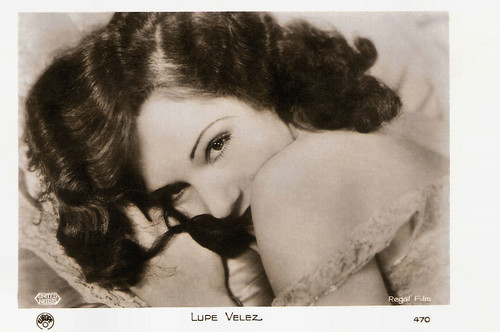
French postcard by Europe, no. 470. Photo: Regal Film / United Artists.

Belgian postcard by S.A. Cacao et Chocolat Kivou, Vilvoorde / N.V. Cacao en Chocolade Kivou, Vilvoorde. PhotoL Artistes Associés (United Artists).
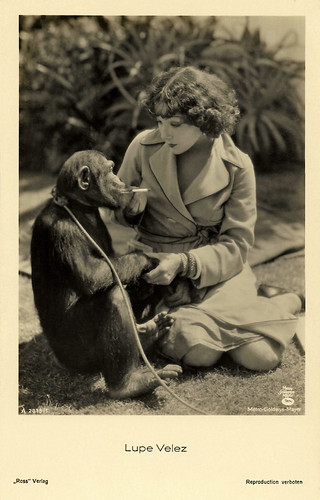
German postcard by Ross Verlag, no. A 2013/1, 1939-1940. Photo: Metro-Goldwyn-Mayer.
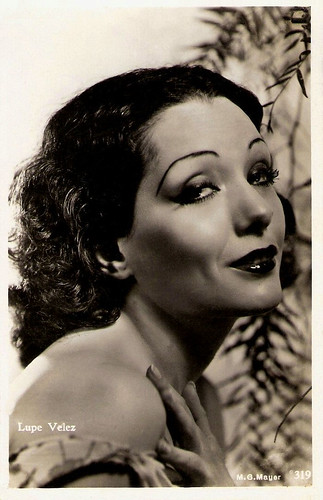
Dutch postcard by JosPe, Arnhem, no. 319. Photo: MGM.
Sources: Denny Jackson (IMDb), Wikipedia, and IMDb.
This post was last updated on 7 March 2021.

Dutch postcard by Smeets & Schippers, Amsterdam. Photo: George Hurrell / MGM (Metro-Goldwyn-Mayer).

German postcard by Ross Verlag, no. 3241/1, 1928-1929. Photo: United Artists. Lupe Velez in The Gaucho (F. Richard Jones, 1929).

German postcard by Ross Verlag, no. 4116/1, 1929-1930. Photo: United Artists. Lupe Velez in Lady of the Pavements (D.W. Griffith, 1929).

German postcard by Ross Verlag, no. 44301/1, 1929-1930. Photo: United Artists.
Suggestive singing and provocative dancing
Lupe Vélez was born María Guadalupe Villalobos Vélez in 1908 in the city of San Luis Potosí in Mexico. She was the daughter of Jacobo Villalobos Reyes, a colonel in the army of the dictator Porfirio Diaz, and his wife Josefina Vélez, an opera singer according to some sources, or vaudeville singer according to others. She had three sisters: Mercedes, Reina, and Josefina, and a brother, Emigdio.
The family was financially comfortable and lived in a large home. At the age of 13, her parents sent her to study at Our Lady of the Lake (now Our Lady of the Lake University) in San Antonio, Texas. It was at Our Lady of the Lake that Vélez learned to speak English and began to dance. She later admitted that she liked dance class, but was otherwise a poor student.
Denny Jackson at IMDb: "Life was hard for her family, and Lupe returned to Mexico to help them out financially. She worked as a salesgirl for a department store for the princely sum of $4 a week. Every week she would turn most of her salary over to her mother, but kept a little for herself so she could take dancing lessons. By now, she figured, with her mature shape and grand personality, she thought she could make a try at show business."
She began her career as a performer in Mexican vaudeville in 1924. She initially performed under her paternal surname, but after her father returned home from the war, he was outraged that his daughter had decided to become a stage performer. She chose her maternal surname, 'Vélez', as her stage name, and her mother introduced Vélez and her sister Josefina to the popular Spanish Mexican vedette María Conesa, 'La Gatita Blanca'.
Vélez debuted in a show led by Conesa, where she sang 'Oh Charley, My Boy' and danced the shimmy. Aurelio Campos, a young pianist, and friend of the Vélez sisters recommended Lupe to stage producers, Carlos Ortega and Manuel Castro. Ortega and Castro were preparing a season revue at the Regis Theatre and hired Vélez to join the company in March 1925.
Later that year, Vélez starred in the revues 'Mexican Rataplan' and '¡No lo tapes!', both parodies of the Bataclan's shows in Paris. Her suggestive singing and provocative dancing were a hit with audiences, and she soon established herself as one of the main stars of vaudeville in Mexico. After a year and a half, Vélez left the revue after the manager refused to give her a raise.
She then joined the Teatro Principal but was fired after three months due to her "feisty attitude". Vélez was quickly hired by the Teatro Lirico, where her salary rose to 100 pesos a day. In 1926, Frank A. Woodyard, an American who had seen Vélez perform, recommended her to stage director Richard Bennett, the father of actresses Joan Bennett and Constance Bennett.
Bennett was looking for an actress to portray a Mexican cantina singer in his upcoming play 'The Dove'. He sent Vélez a telegram inviting her to Los Angeles to appear in the play. Vélez had been planning to go to Cuba to perform, but quickly changed her plans and traveled to Los Angeles. However, upon arrival, she discovered that she had been replaced by another actress.

French postcard by Cinémagazine-Edition, Paris, no. 521. Douglas Fairbanks and Lupe Velez in The Gaucho (F. Richard Jones, 1927). Sent by mail in 1930.

German postcard by Ross Verlag, no. 3493/1, 1928-1929. Photo: P.D.C. Lupe Velez and Rod La Rocque in Stand and Deliver (Donald Crisp, 1928).

French postcard by Europe, no. 457. Photo: United Artists / Regal Film.

French postcard by Europe, no. 650. Photo: Paramount. Lupe Velez in The Wolf Song (Victor Fleming, 1929).
Whoopee Lupe
While in Los Angeles, Lupe Vélez met the comedian Fanny Brice. Brice recommended her to Florenz Ziegfeld Jr., who hired her to perform in New York City. While Vélez was preparing to leave Los Angeles, she received a call from MGM producer Harry Rapf, who offered her a screen test. Producer and director Hal Roach saw Vélez's screen test and hired her for a small role in the comic Laurel and Hardy short Sailors, Beware! (Fred Guiol, Hal Yates, 1927).
After her debut, Vélez appeared in another Hal Roach short, What Women Did for Me (James Parrott, 1927), opposite Charley Chase. Later that year, she did a screen test for the upcoming Douglas Fairbanks feature The Gaucho (F. Richard Jones, 1927). Fairbanks was impressed by Vélez and hired her to appear in the film with him.
The Gaucho (F. Richard Jones, 1927) was a hit and critics were duly impressed with Vélez's ability to hold her own alongside Fairbanks, who was well known for his spirited acting and impressive stunts. Her second major film was Stand and Deliver (Donald Crisp, 1928), produced by Cecil B. DeMille. That same year, she was named one of the WAMPAS Baby Stars.
Then she appeared in Lady of the Pavements (1929), directed by D. W. Griffith, and Where East Is East (Tod Browning, 1929), starring Lon Chaney as an animal trapper in Laos. In the Western The Wolf Song (Victor Fleming, 1929), she appeared alongside Gary Cooper. As she was regularly cast as 'exotic' or 'ethnic' women that were volatile and hot-tempered, gossip columnists took to referring to Vélez as "Mexican Hurricane", "The Mexican Wildcat", "The Mexican Madcap", "Whoopee Lupe" and "The Hot Tamale".
Lupe Vélez made the transition to sound films without difficulty. Studio executives had predicted that her accent would likely hamper her ability to make the transition. That idea was dispelled after she appeared in the all-talking Rin Tin Tin vehicle, Tiger Rose (George Fitzmaurice, 1929). The film was a hit and Vélez's sound career was established.
Vélez appeared in a series of Pre-Code films like Hell Harbor (Henry King, 1930), The Storm (William Wyler, 1930), and the crime drama East Is West (Monta Bell, 1930) opposite Edward G. Robinson. The next year, she appeared in her second film for Cecil B. DeMille, Squaw Man (Cecil B. DeMille, 1931), opposite Warner Baxter, in Resurrection (Edwin Carewe, 1931), and The Cuban Love Song (W.S. Van Dyke, 1931), with the popular singer Lawrence Tibbett.
She had a supporting role in Kongo (William J. Cowen, 1932) with Walter Huston, a sound remake of West of Zanzibar (Tod Browning, 1928) which tries to outdo the Lon Chaney original in morbidity. She also starred in Spanish-language versions of Universal films like Resurrección (Eduardo Arozamena, David Selman, 1931), the Spanish version of Resurrection (1931), and Hombres en mi vida (Eduardo Arozamena, David Selman, 1932), the Spanish version of Men in Her Life (William Beaudine, 1931) in which Lois Moran had starred.

German postcard by Ross Verlag, no. 4989/1, 1929-1930. Photo: Paramount. Lupe Velez in The Wolf Song (Victor Fleming, 1929). Sent by mail in The Netherlands in 1932.

Dutch postcard by Croeze Bosman Universal, no. 57. Lupe Velez in The Storm (William Wyler, 1930).

Dutch postcard by Croeze Bosman Universal, no. 61.

German cigarette card by Ross Verlag in the 'Künstler im Film' series for Zigarettenfabrik Monopol, Dresden, Serie 1, image 152 (of 200). Photo: Paramount. Lupe Velez in The Broken Wing (Lloyd Corrigan, 1932).
Hot Pepper
In 1932, Lupe Vélez took a break from her film career and traveled to New York City where she was finally signed by Broadway impresario Florenz Ziegfeld, Jr. to take over the role of 'Conchita' in the musical revue 'Hot-Cha!'. The show also starred Bert Lahr, Eleanor Powell, and Buddy Rogers.
Back in Hollywood, Lupe switched to comedy after playing dramatic roles for five years. Denny Jackson at IMDb: "In 1933 she played the lead role of Pepper in Hot Pepper (1933). This film showcased her comedic talents and helped her to show the world her vital personality. She was delightful."
After Hot Pepper (John G. Blystone, 1933) with Edmund Lowe and Victor McLaglen, Lupe played beautiful but volatile, characters in a series of successful films like Strictly Dynamite (Elliott Nugent, 1934), Palooka (Benjamin Stoloff, 1934) both opposite Jimmy Durante, and Hollywood Party (Allan Dwan, a.o., 1934) with Laurel and Hardy.
Although Vélez was a popular actress, RKO Pictures did not renew her contract in 1934. Over the next few years, Vélez worked for various studios as a freelance actress; she also spent two years in England where she filmed The Morals of Marcus (Miles Mander, 1935) and Gypsy Melody (Edmond T. Gréville, 1936). She returned to Los Angeles the following year where she appeared in the final part of the Wheeler & Woolsey comedy High Flyers (Edward F. Cline, 1937).
In 1938, Vélez made her final appearance on Broadway in the musical 'You Never Know', by Cole Porter. The show received poor reviews from critics but received a large amount of publicity due to the feud between Vélez and fellow cast member Libby Holman. Holman was irritated by the attention Vélez garnered from the show with her impersonations of several actresses including Gloria Swanson, Katharine Hepburn, and Shirley Temple. The feud came to a head during a performance in New Haven, Connecticut after Vélez punched Holman in between curtain calls and gave her a black eye. The feud effectively ended the show.
Upon her return to Mexico City in 1938 to star in her first Mexican film, Vélez was greeted by ten thousand fans. The film La Zandunga (Fernando de Fuentes, 1938) co-starring Arturo de Córdova, was a critical and financial success. Vélez was slated to appear in four more Mexican films, but instead, she returned to Los Angeles and went back to work for RKO Pictures.
In 1939, Lupe Vélez was cast opposite Leon Errol and Donald Woods in the B-comedy, The Girl from Mexico (Leslie Goodwins, 1939). Despite being a B film, it was a hit with audiences and RKO re-teamed her with Errol and Wood for a sequel, Mexican Spitfire (Leslie Goodwins, 1940). That film was also a success and led to a series of eight Spitfire films.
Wikipedia: "In the series, Vélez portrays Carmelita Lindsay, a temperamental yet friendly Mexican singer married to Dennis 'Denny' Lindsay (Woods), an elegant American gentleman. The Spitfire films rejuvenated Vélez's career. Moreover, they were films in which a Latina headlined for eight films straight – a true rarity."
In addition to the Spitfire series, she was cast in such films as Six Lessons from Madame La Zonga (John Rawlins, 1941), Playmates (David Butler, 1941) opposite John Barrymore, and Redhead from Manhattan (Lew Landers, 1943). In 1943, the final film in the Spitfire series, Mexican Spitfire's Blessed Event (Leslie Goodwins, 1943), was released. By that time, the novelty of the series had begun to wane.
Velez co-starred with Eddie Albert in the romantic comedy, Ladies' Day (Leslie Goodwins, 1943), about an actress and a baseball player. In 1944, Vélez returned to Mexico to star in an adaptation of Émile Zola's novel Nana (Roberto Gavaldón, Celestino Gorostiza, 1944), which was well-received. It would be her final film. After filming wrapped, Vélez returned to Los Angeles and began preparing for another stage role in New York.

British Real Photograph postcard. Photo: Metro-Goldwyn-Mayer.

Italian postcard by Cinema-Illustrazione, Milano, Serie 1, no. 36. Photo: Metro-Goldwyn-Mayer.

Austrian postcard by Iris Verlag, no. 6744. Photo: Radio Pictures.
Scratches, bruises, and love-bites
Lupe Vélez's temper and jealousy in her often tempestuous romantic relationships were well documented and became tabloid fodder, often overshadowing her career. Vélez was straightforward with the press and was regularly contacted by gossip columnists for stories about her romantic exploits.
Her first long-term relationship was with actor Gary Cooper. Vélez met Cooper while filming The Wolf Song in 1929 and began a two-year affair with him. The relationship was passionate but often stormy. Reportedly Vélez chased Cooper around with a knife during an argument and cut him severely enough to require stitches. By that time, the rocky relationship had taken its toll on Cooper who had lost 45 pounds and was suffering from nervous exhaustion. Paramount Pictures ordered him to take a vacation to recuperate. While he was boarding the train, Vélez showed up at the train station and fired a pistol at him.
During her marriage to actor Johnny Weissmuller, stories of their frequent physical fights were regularly reported in the press. Vélez reportedly inflicted scratches, bruises, and love-bites on Weissmuller during their fights and "passionate love-making". In July 1934, after ten months of marriage, Vélez filed for divorce citing cruelty. She withdrew the petition a week later after reconciling with Weissmuller. In January 1935, she filed for divorce a second time and was granted an interlocutory decree that was dismissed when the couple reconciled a month later. In August 1938, Vélez filed for divorce for a third time, again charging Weissmuller with cruelty. Their divorce was finalised in August 1939.
After the divorce became final, Vélez began dating actor Guinn "Big Boy" Williams in late 1940. They were reportedly engaged but never married. Vélez was also linked to author Erich Maria Remarque and the boxers Jack Johnson and Jack Dempsey.
In 1943, Vélez began an affair with her La Zandunga co-star Arturo de Córdova. De Córdova had recently moved to Hollywood after signing with Paramount Pictures. Despite the fact that de Córdova was married to Mexican actress Enna Arana with whom he had four children, Vélez granted an interview to gossip columnist Louella Parsons in September 1943 and announced that the two were engaged. Vélez ended the engagement in early 1944, reportedly after de Córdova's wife refused to give him a divorce.
Vélez then met and began dating a struggling young Austrian actor named Harald Maresch who went by the stage name Harald Ramond. In September 1944, she discovered she was pregnant with Ramond's child. She announced their engagement in late November 1944. On 10 December, four days before her death, Vélez announced she had ended the engagement and kicked Ramond out of her home.
On the evening of 13 December 1944, Vélez dined with her two friends, the silent film star Estelle Taylor and Venita Oakie. In the early morning hours of 14 December, Vélez retired to her bedroom, where she consumed 75 Seconal pills and a glass of brandy. Her secretary, Beulah Kinder, found the actress's body on her bed later that morning. A suicide note addressed to Harald Ramond was found nearby. Lupe Vélez was only 36 years old.
More than four-thousand people filed past her casket during her funeral. Her body was interred in Mexico City, at Panteón Civil de Dolores Cemetery. Velez's estate, valued at $125,000 and consisting mostly of her Rodeo House home, two cars, jewelry, and personal effects were left to her secretary Beulah Kinder with the remainder in trust for her mother, Mrs. Josephine Velez. Together with Dolores del Rio, Ramon Novarro, and José Mojica, she was one of the few Mexican people who had made history in the early years of Hollywood.

French postcard by Europe, no. 470. Photo: Regal Film / United Artists.

Belgian postcard by S.A. Cacao et Chocolat Kivou, Vilvoorde / N.V. Cacao en Chocolade Kivou, Vilvoorde. PhotoL Artistes Associés (United Artists).

German postcard by Ross Verlag, no. A 2013/1, 1939-1940. Photo: Metro-Goldwyn-Mayer.

Dutch postcard by JosPe, Arnhem, no. 319. Photo: MGM.
Sources: Denny Jackson (IMDb), Wikipedia, and IMDb.
This post was last updated on 7 March 2021.
No comments:
Post a Comment